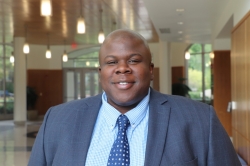Stress and Learning During a Pandemic
From ambient sounds of a café to generational accommodations, Dr. James Vines prescribed creativity and adaptation for academic success

For an experienced student retention expert like James Vines, PhD, listening to nursing students explain their academic challenges and digging deeper for confounding factors is a daily activity. The COVID-19 pandemic, however, added a myriad of new obstacles for students aiming to achieve their goals in a rigorous curriculum.
In partnering with students for their academic success, the Fitzpatrick College of Nursing’s Student Success and Retention Advisor saw an additional layer of challenge in social, psychological, and financial realms following the emergency transition of the university from in-person classes to all online learning in March 2020.
“It was a new level of stress,” notes Dr. Vines. “College students – especially nursing students- are already stressed. Being tech savvy wasn’t the issue; they’re tech savvy for the most part. They had to go back home with siblings who might be anywhere from K-12 in school, or even siblings who were also in college.” Where could they work?
While the number of students with academic challenges stayed the same, Dr. Vines noted an increase in self-identified students who were under stress. The students were noticing “Wait a minute, I am at home, how am I going to do this?” Some were time zones away, so Dr. Vines had to remember that when students were trying to schedule a meeting with him via zoom for support. Learning from home also created more distractions for those who were prone to succumbing to them instead of logging in, versus learning at school where some classmates role modeled for others in terms of launching the learning day.
Dr. Vines tried to resonate with them. He had lived in a city apartment growing up and shared with students what they might do to help find a space where they could work at home. For some, that meant their room, or a designated time at the kitchen table or in a certain section of the home.
Many students had financial concerns. Some parents were not working so students took on jobs to help with the bills, by picking up a shift with Uber or DoorDash, for instance. Certain families had a bandwidth issue and had to pay more to their service provider to allow all household learners to be on the Internet at the same time which was an increased financial burden for them.
“Some students were stressed because they couldn’t get out of the house. They thought they were not allowed to leave their homes,” says Dr. Vines. He told students, “The biggest thing is to keep your routine, get up, shower, eat, walk, play with the dog.” He found that they were less “on edge” after being outside.
Students were used to a different type of living and learning environment while at school, one which included coffee shops. He told them to re-create the atmosphere if that would be helpful to them, their studying and their stress level. “I suggested that they check YouTube and get background music to mimic what they would hear while they were out, even coffee shop noises... at this point we had to get as creative as possible,” recalls Dr. Vines.
His interactions and solutions also related to culture in the home. “I had to have some uncomfortable conversations that were culturally related. One student had grandparents living in the house and there was an expectation that the student sit down for dinner with the family, even though the student was just getting out of class and would normally then be studying. Other college-aged siblings were having the same issue, so they were all able to talk to the family and came to a resolution. It was critical, notes Dr. Vines, to look at “What is going on in the home?”
In describing the students, he says, “Overall, they are really hard-working, they kept the momentum going and rose to the challenge. I am proud that they continued into the fall semester being responsible. The students were good about reaching out, even those in jeopardy pulled through.”
He smiles recalling student creativity with Zoom and Kahoot!. “I like that they didn’t get grumpy about the situation but got creative. They stepped up,” playing music and online games, he says, “Students put on this hat of ‘this is where we are, and this is what we can do.’”
